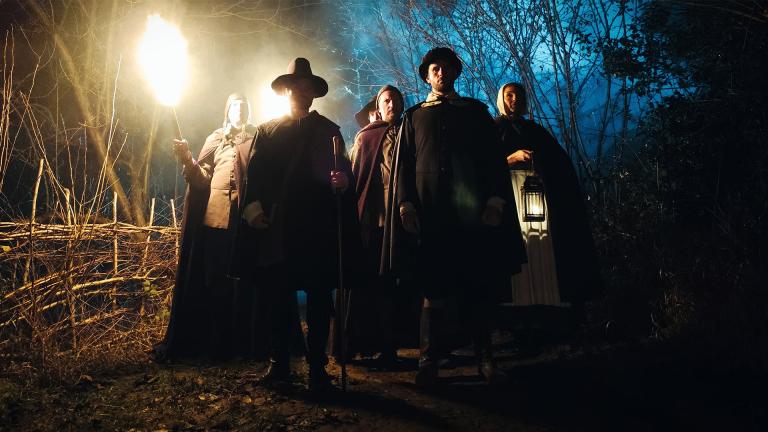
Read more about British History

If you are fascinated by the ‘witch craze’ of Stuart England, you have likely come across the term ‘Witchfinder General’ more than a few times. It was the self-bestowed title of Matthew Hopkins, who took it upon himself to investigate hundreds of alleged witchcraft cases during the English Civil War.
Due to Hopkins’ efforts, the rate of witchcraft executions spiked in the 1640s after a lull of several decades. However, he certainly didn’t act alone. He was closely assisted by his right-hand man John Stearne, whose own culpability for genocidal ‘witch’ deaths is often overlooked by historians.
Stearne was especially pivotal in helping Hopkins to prosecute Elizabeth Clarke in 1645. Her tragic story is told in the new Sky HISTORY docuseries Witches of Essex. So, why has Stearne’s involvement in Hopkins’ witch-hunting attracted little dedicated attention?
Witches of Essex starts Tuesday 14 October 9pm on Sky HISTORY and HISTORY Play.
To put a long story short — even less than we know about Hopkins’! Much of what we do know has been garnered from inferences. For example, while Stearne’s birth can be traced to about 1610, it’s not known for definite where he was born. The Suffolk village of Long Melford (where Stearne grew up) is one viable candidate.
Stearne later acquired land at another Suffolk village, Lawshall, which lies close to Bury St Edmunds. In the Essex town of Manningtree, Stearne owned a property where he is thought to have met Hopkins, who was 10 years younger. Stearne likely would have been in his mid-thirties around this time.
Today, Stearne is widely regarded as the second fiddle of Hopkins’ witch-hunting operations. Initially, though, Stearne actually made Hopkins his own assistant rather than vice-versa. It was only later that these roles were reversed.
Reflecting his more proactive approach early in the partnership, Stearne accused multiple Manningtree women of sorcery in 1644. Hopkins subsequently sought ‘evidence’ of these crimes, such as by searching suspects’ bodies for signs of the ‘Devil’s Mark’. His efforts eventually culminated in as many as 36 local women standing trial for witchcraft. Of these, 19 were convicted and hanged.
Of course, Matthew Hopkins is the one immortalised today as the ‘Witchfinder General’. However, John Stearne picked up some nicknames of his own, including simply ‘the witch-hunter’ and the slightly more imaginative ‘witch pricker’.
The latter epithet came from his reputation for physically pricking suspected witches to see if they would bleed. If they didn’t, this would be seen as an incriminating sign that they had indeed practiced witchcraft.
This wasn’t the only method Stearne would resort to in his bids to ‘prove’ allegations of witchcraft. With Stearne’s help, Hopkins used sleep deprivation to essentially force Elizabeth Clarke into confessing her own supposed guilt.
Stearne continued to follow Hopkins on his reign of terror, which started in Essex before spreading further afield. Nonetheless, the pair remained primarily active in East Anglia. They were actually a little too successful for their own good in Bury St Edmunds, where they secured dozens of convictions.
The sheer number was enough to make locals suspect foul play. Sure, this was a godly society with genuine belief in the existence of witchcraft, but there remained fears about potential miscarriages of justice. Would suitably rigorous investigations really result in so many guilty verdicts?
Hopkins and Stearne would be paid handsomely for landing convictions. This only contributed to growing speculation that Hopkins and Stearne were motivated more by these financial rewards than any altruistic sense of doing 'God’s work’.
Hopkins and Stearne continued their barbaric anti-witchcraft crusade for a total of 14 months before the game was finally up. The tide of public opinion was dramatically turning against the two men, especially as the English Civil War was also winding down. It left ordinary people with fewer misfortunes worth attributing to witches.
After Hopkins passed away in August 1647, his former colleague went into retirement and wrote A Confirmation and Discovery of Witchcraft. In this text, Stearne denied taking bribes and insisted that he had acted mainly out of godly zeal. The money he did make from his endeavours, he claimed, barely covered his travel and lodging expenses.
In any case, Stearne’s well-publicised status as mere assistant — rather than leader — of the Witchhunter General campaigns consigned him to the footnotes of history.
Want to learn about other overlooked names of the witching era? You can start by subscribing to the Sky HISTORY Newsletter today.